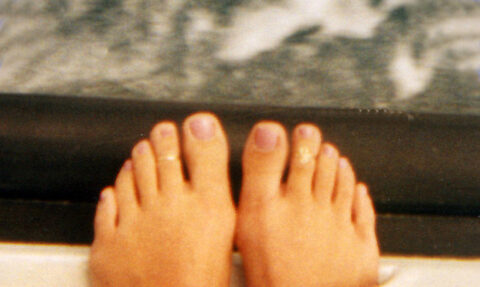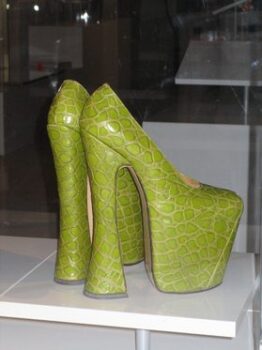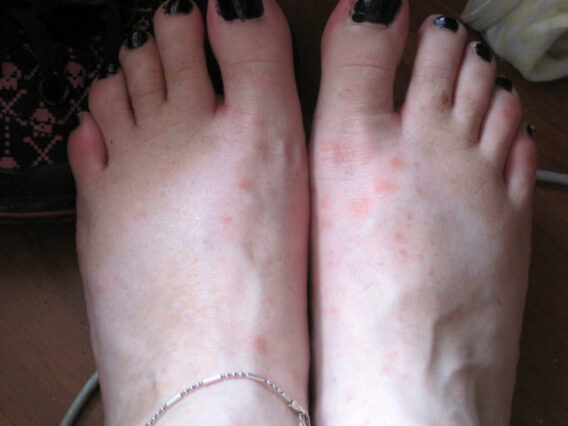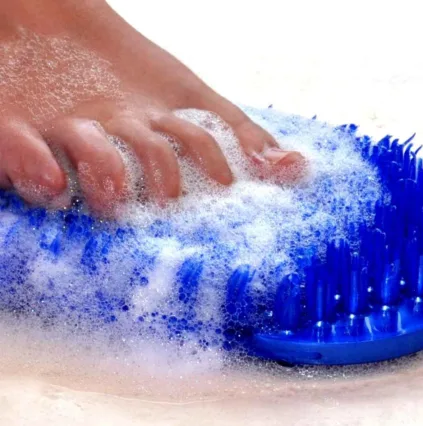Got cold feet? Some people have cold feet year-round. I do… especially during the winter months.
If you’re not interested in trying foot warmers like these, then here’s how you can warm up your cold feet no matter where you are!
4 Ways To Warm Up Your Feet
- Warm up your cold feet with movement.
Try this:
Stand on your tippy toes for a couple of minutes, then quickly come back down on your heels. Repeat several times until you feel your blood tingling through your feet and warming them up.
- Warm up your cold feet with a hot bath.
Take a relaxing foot soak in warm (not hot) water followed by a pair of warm socks. Oh, who am I kidding?… I usually just go for the full-out body soak in the bathtub. That’s how I warm up all over… and fast! (In the winter, I sometimes take 3 baths a day!)
- Warm up your cold feet with chili powder.
Do this with caution, as too much of anything is a good thing… and this is especially true with chili powder!
Simply rub it directly onto the soles of your feet and the tops of your toes. Don’t go much higher, as it may cause irritation.
- Warm up your cold feet with cayenne pepper.
When you eat red pepper, its active ingredient, capsaicin, increases the circulation in your toes and fingers. When you put cayenne (or red pepper spices) into your shoes or socks, you’re doing the same thing… topically. For some people, the warming sensation happens immediately, for others, the heat gradually increases over time. (It also depends on how much you use.)
Cayenne causes the blood vessels under the skin of the feet to dilate, thus stimulating extra blood flow and providing warmth to the feet.
Source
How To Use Cayenne In Your Shoes Or Socks:
- Turn your socks almost inside out, and sprinkle a teaspoon of cayenne pepper into the portion of the sock where your toes and the top of your foot will be. Then slip your foot inside. Make sure the pepper is distributed evenly across the bottom of each sock. And let the warming sensation begin!
- If you feel inclined to use more than a teaspoon of the cayenne pepper, then add it to a “base” of talcum powder or cornstarch first. Then sprinkle the mixture inside your socks.
- Or, you could wear a thin pair of socks normally over your feet. Then sprinkle the inside of a thicker pair of socks with cayenne pepper, and put them on over the thin socks.
- Just the same, you could try sprinkling the bottom of your socks, instead of filling them inside.
- If you don’t want to take any chances of the pepper coming into contact with you feet, put a tiny bit of dried, powdered cayenne into a plastic or cloth bag. Seal it tightly, and place it next to your cold feet to warm them.
- You could also sprinkle the mixture inside your shoes, rather than inside your socks.
Warnings Regarding Cayenne, Chili Powder & Capsaicin
- Cayenne and chili powder will cause your white socks to turn pink and your feet to turn red. (Plus, they will kind of smell like chili!)
- To avoid irritation, your best bet would be to not let the cayenne pepper or chili powder come into direct contact with your feet.
- Do not use chili powder or cayenne pepper if your feet have any cuts, scrapes, or blisters.
- Wash your hands thoroughly after applying, because even one grain that’s left on your finger can burn tremendously if you rub your eyes, or if it comes in contact with your contact lenses.
- Don’t place too much inside your shoes or socks… you may find it warms your feet more than you can stand.
Here’s a bit more than you ever wanted to know about cold feet (especially as it pertains to skiers’ cold feet)… It’s the patent information for a cayenne pepper-based foot powder.
More About The Relationship Between Cold Feet & Cayenne Pepper:
- Pepper Profile
- 6 Reasons To Add Cayenne To Your Diet
- Herbs & Spices That Keep You Warm & Healthy
- All About Cayenne
- More About Capsaicin, Capsicum, Cayenne, and Chili Pepper
- Pungent Capsicums Offer A Wide Array Of Health Benefits
- Tips For Runners Who Get Cold Feet
Keep in mind, your cold feet could signal a bigger problem, such as Raynaud’s disease — a circulatory problem in which the hands and feet have hypersensitivity to the cold. In fact, you may want to discuss your cold feet with your doctor.
Who knew that I'd be writing about feet for a living?!… Or even that a website devoted solely to feet, shoes, and foot care issues would be successful? But as it turns out, many people have questions and concerns about their feet — and we do our best to provide the most helpful answers here. Myself and a handful of others who happen to have some rather unique foot issues share our firsthand experiences with everything from ingrown toenails, bunions, calluses and rough feet to trendy shoes and helpful foot modeling tips. When I'm not writing about all things below the ankle, you will find me at the corner of Good News & Fun Times as publisher of The Fun Times Guide (32 fun & helpful websites).










